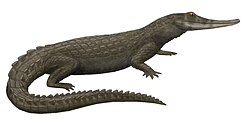Atoposauridae
| Atoposauridae Temporal range:
| |
|---|---|

| |
| Specimen of Alligatorellus | |

| |
| Life restoration of Knoetschkesuchus | |
| Scientific classification | |
| Domain: | Eukaryota |
| Kingdom: | Animalia |
| Phylum: | Chordata |
| Class: | Reptilia |
| Clade: | Archosauria |
| Clade: | Pseudosuchia |
| Clade: | Crocodylomorpha |
| Clade: | Eusuchia |
| Family: | †Atoposauridae Gervais, 1871 |
| Genera | |
| Synonyms | |
| |
Atoposauridae is an extinct family of neosuchian crocodyliforms, known from the Jurassic and Cretaceous of Eurasia. Characterised by their small size and their heterodont (having multiple tooth types) dentition, they are thought to have lived in terrestrial and semi-aquatic environments,[1] and to have consumed small prey such as fish, insects and mammals.[1][2] The oldest records of the group are known from the Middle Jurassic of Britain.[3] The majority of the family are known from Late Jurassic to Early Cretaceous deposits in France, Portugal, and Bavaria in southern Germany.[1][4][5] The discovery of the genus Aprosuchus, however, extends the duration of the lineage to the end of the Cretaceous in Romania.[6]
Classification
[edit]Atoposaurids are universally considered members of Neosuchia. Tennant et al. (2016) in their revision of the group, found atoposaurids to be basal neosuchians, and the group as traditionally defined to be paraphyletic with respect to Paralligatoridae, restricting Atoposauridae to only include the genera Alligatorium, Alligatorellus and Atoposaurus.[1] However Schwarz et al, (2017) found the traditional Atoposauridae as a whole to be monophyletic and the sister group to Paralligatoridae within the Eusuchia.[4] A similar result was found by Pochat-Cottilloux et al (2024).[7]
Phylogeny
[edit]Cladogram modified from Buscalioni and Sanz (1988)[8] and Buscalioni and Sanz (1990):[9]
| Atoposauridae | |
References
[edit]- ^ a b c d Tennant, Jonathan P.; Mannion, Philip D.; Upchurch, Paul (2016). "Evolutionary relationships and systematics of Atoposauridae (Crocodylomorpha: Neosuchia): implications for the rise of Eusuchia" (PDF). Zoological Journal of the Linnean Society. 177 (4): 854–936. doi:10.1111/zoj.12400.
- ^ Guillaume, Alexandre R D; Moreno-Azanza, Miguel; Puértolas-Pascual, Eduardo; Mateus, Octávio (2019-11-30). "Palaeobiodiversity of crocodylomorphs from the Lourinhã Formation based on the tooth record: insights into the palaeoecology of the Late Jurassic of Portugal". Zoological Journal of the Linnean Society. 189 (2): 549–583. doi:10.1093/zoolinnean/zlz112. ISSN 0024-4082.
- ^ Young, Mark T.; Tennant, Jonathan P.; Brusatte, Stephen L.; Challands, Thomas J.; Fraser, Nicholas C.; Clark, Neil D. L.; Ross, Dugald A. (2016-02-01). "The first definitive Middle Jurassic atoposaurid (Crocodylomorpha, Neosuchia), and a discussion on the genus Theriosuchus". Zoological Journal of the Linnean Society. 176 (2): 443–462. doi:10.1111/zoj.12315. ISSN 0024-4082.
- ^ a b Schwarz, Daniela; Raddatz, Maik; Wings, Oliver (2017-02-15). "Knoetschkesuchus langenbergensis gen. nov. sp. nov., a new atoposaurid crocodyliform from the Upper Jurassic Langenberg Quarry (Lower Saxony, northwestern Germany), and its relationships to Theriosuchus". PLOS ONE. 12 (2): e0160617. Bibcode:2017PLoSO..1260617S. doi:10.1371/journal.pone.0160617. ISSN 1932-6203. PMC 5310792. PMID 28199316.
- ^ Tennant, Jonathan P.; Mannion, Philip D. (2014-09-25). "Revision of the Late Jurassic crocodyliform Alligatorellus, and evidence for allopatric speciation driving high diversity in western European atoposaurids". PeerJ. 2: e599. doi:10.7717/peerj.599. ISSN 2167-8359. PMC 4179893. PMID 25279270.
- ^ Márton Venczel; Vlad A. Codrea (2019). "A new Theriosuchus-like crocodyliform from the Maastrichtian of Romania". Cretaceous Research. 100: 24–38. Bibcode:2019CrRes.100...24V. doi:10.1016/j.cretres.2019.03.018. S2CID 133729562.
- ^ Pochat-Cottilloux, Yohan; Lauprasert, Komsorn; Chanthasit, Phornphen; Manitkoon, Sita; Adrien, Jérôme; Lachambre, Joël; Amiot, Romain; Martin, Jeremy E (2024-10-01). "New Cretaceous neosuchians (Crocodylomorpha) from Thailand bridge the evolutionary history of atoposaurids and paralligatorids". Zoological Journal of the Linnean Society. 202 (2). doi:10.1093/zoolinnean/zlad195. ISSN 0024-4082.
- ^ Buscalioni, Angela D; José Luis Sanz (1988). "Phylogenetic relationships of the Atoposauridae (Archosauria, Crocodylomorpha)". Historical Biology. 1 (3): 233–250. Bibcode:1988HBio....1..233B. doi:10.1080/08912968809386477.
- ^ Buscalioni, A. D.; Sanz, J. L. (1990). "Montsecosuchus depereti (Crocodylomorpha, Atoposauridae), new denomination for Alligatorium depereti Vidal, 1915 (Early Cretaceous, Spain): Redescription and phylogenetic relationships". Journal of Vertebrate Paleontology. 10 (2): 244–254. Bibcode:1990JVPal..10..244B. doi:10.1080/02724634.1990.10011810.



